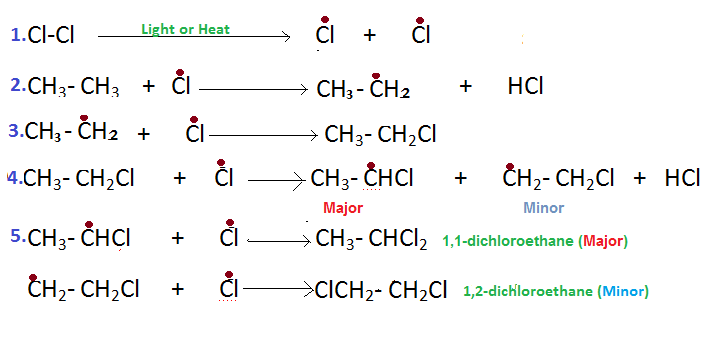Let the chlorination reaction of Ethane #(C_2H_6)# with chlorine replaces n atoms from its molecule producing chloro ethane of formula #C_2H_(6-n)Cl_n#
Considering atomic masses as
#C=12g/"mol"#
#H=1g/"mol"#
#Cl=35.5g/"mol"#
We get the molar mass of chloroethane as
#2xx12+(6-n)xx1+nxx35.5#
#=30+34.5n#
And % Cl in the compound as calculated from its molecular formula #C_2H_(6-n)Cl_n# will be
#=(35.5xxnxx100)/(30+34.5n)#
Equating this with the given percentage we can write
#(35.5xxnxx100)/(30+34.5n)=71.7#
#=> (35.5xxnxx100)/71.7=(30+34.5n)#
#=> 49.5n=(30+34.5n)#
#=> 49.5n-34.5n=30#
#=>n=30/15=2#
(A) Hence the molecular formula of chloroethane is #C_2H_4Cl_2#
(B) The condensed structural formula and name of the isomers
#CH_3CHCl_2->1,1-"dichloroethane"#
#CH_2ClCH_2Cl->1,2-"dichloroethane"#
(C) Between the two isomers the major product will be
#CH_3CHCl_2->"1,1-dichloroethane"#
The reaction follows free radical mechanism.
(1) #Cl*# free radical is first produced by homolytic fission of #Cl-Cl" "sigmabond# under the influence of light or heat energy.
(2)This #Cl*# free radical extracts #H# atom from #CH_3CH_3# molecule forming #CH_3CH_2*# free radical
(3) #CH_3CH_2*# free radical then combines with #Cl*# free radical to form #CH_3CH_2Cl# ,monochloroethane.
(4) Now the extraction of #H"-atom"# from #CH_3CH_2Cl# by #Cl*# again occurs with two possibilities forming #CH_3CHCl*# or #*CH_2CH_2Cl#
(5) The first one #color(blue)(CH_3CHCl*)# is more stable free radical as it has got more #alpha"H# in respect of free radical providing higher hyper conjugative effect. So the first one which is formed in higher concentration in the reaction mixture,will combine with #Cl*# free radical more and thus the major product will be
#color(red)(CH_3CHCl_2->"1,1-dichloroethane")#



